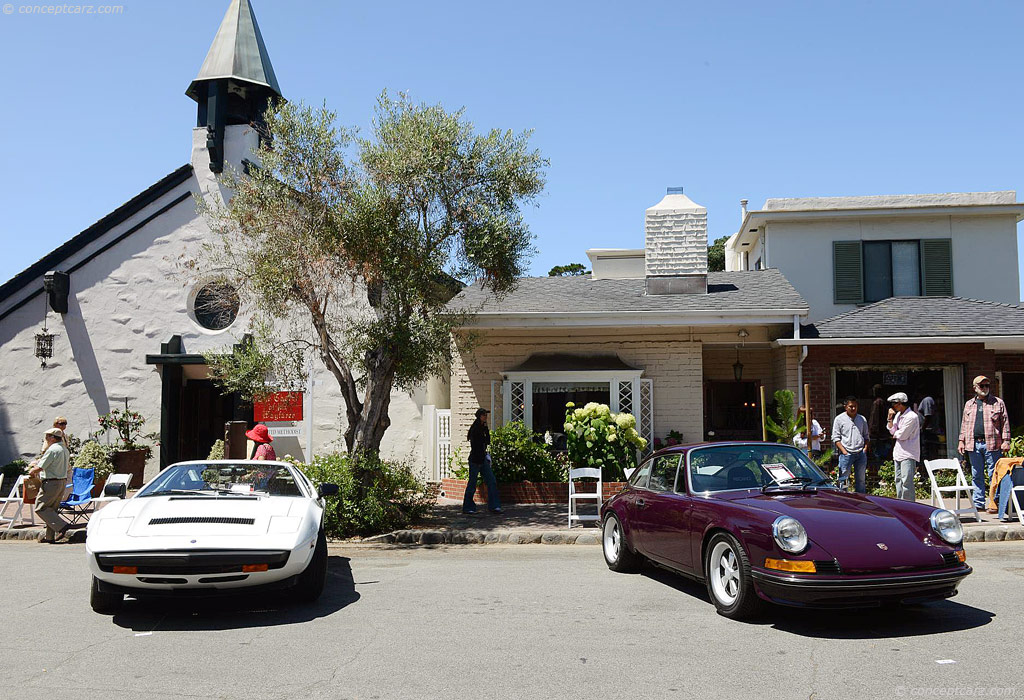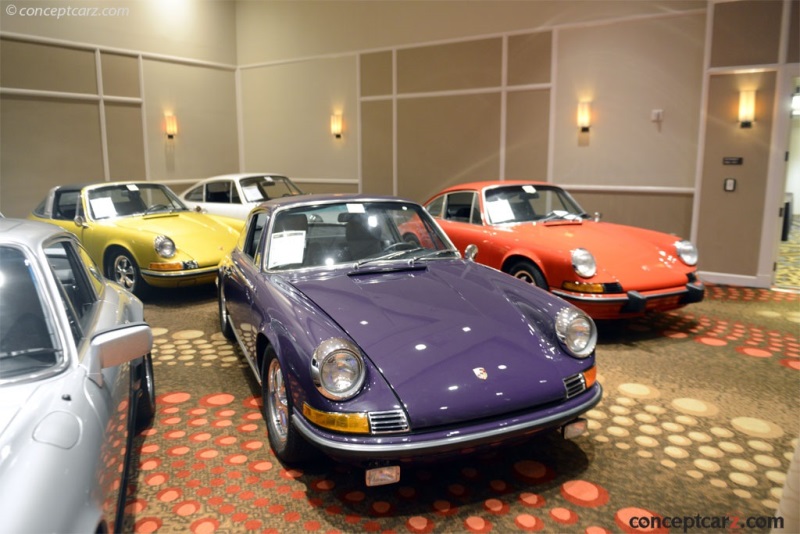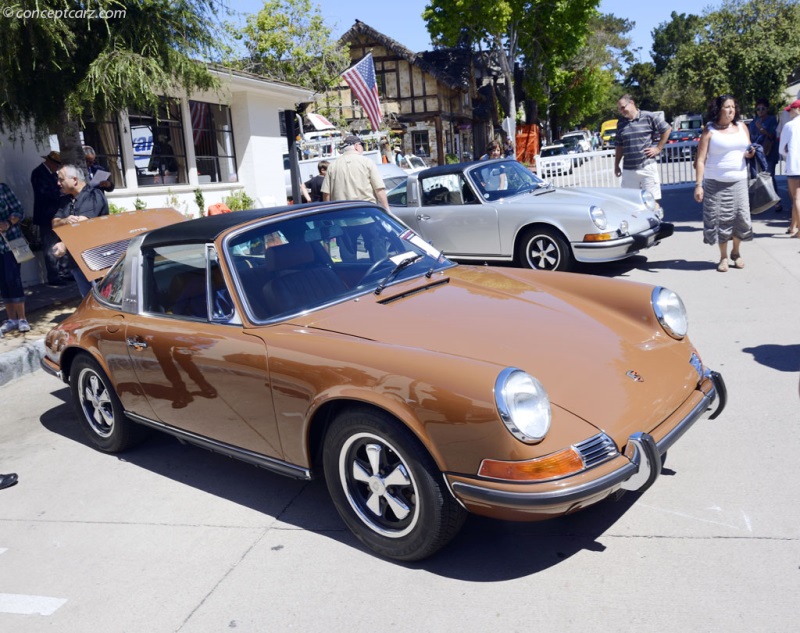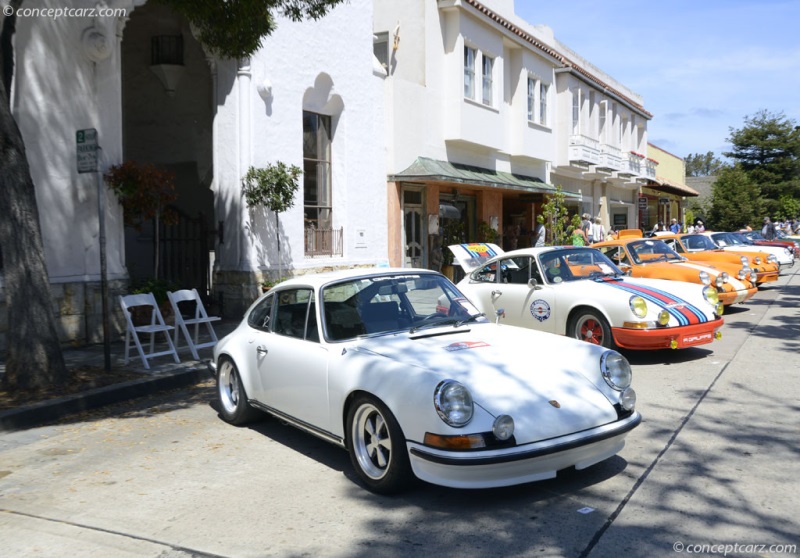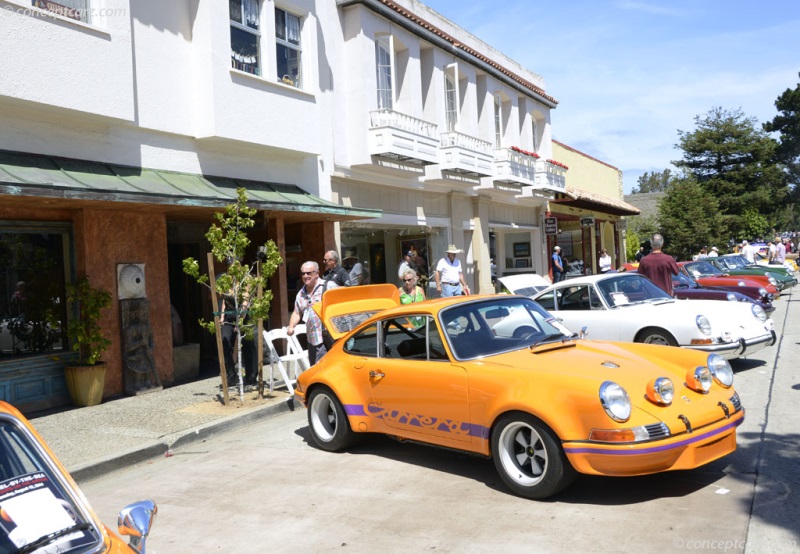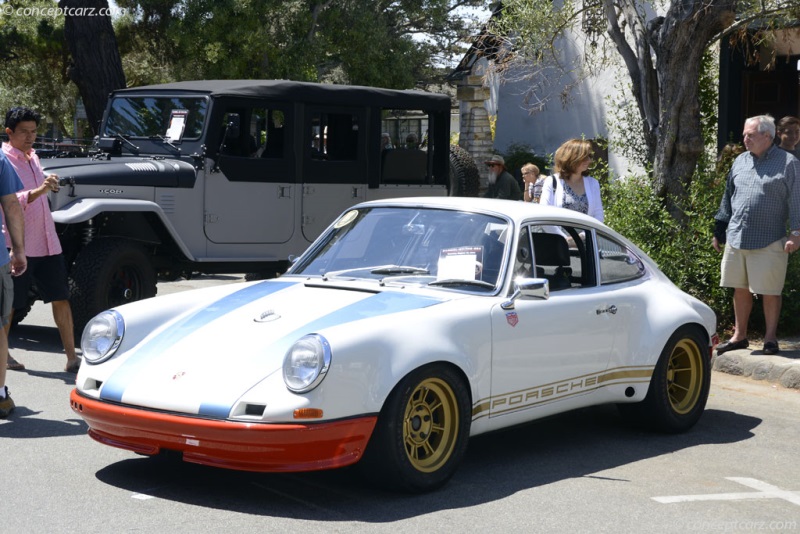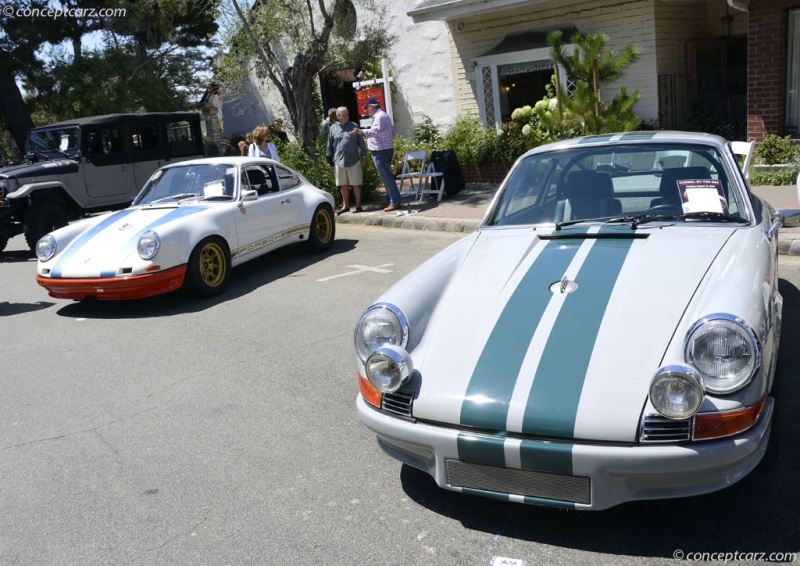The timeless design of the Porsche 911, first entering production in 1964, was the work of Ferdinand 'Butzi' Porsche and the company's joint founder and chief body engineer Erwin Komenda. It quickly established a renowned reputation for its unparalleled driveability, a product of precise rack and pinion steering, torsion bar suspension, and disc brakes front and rear. The early examples were equipped with a dry-sump, air-cooled, two-liter, flat-six engine mounted at the rear and backed by a four- or five-speed all-synchromesh transmission.
CoupeThe 911 was introduced at the Frankfurt Auto Show in September 1963 and had a resemblance to the previous model but with a unit-body chassis, a more powerful and smoother engine, a quieter interior, and more space for people and luggage than the outgoing 356. The 911 body was functional and attractive in an ageless design that remained mostly unchanged right up to the '992' generation, introduced in 2019. The high-performance 911 S model appeared in 1967 wearing lightweight 'Fuchs' five-spoke alloy wheels. In 1968, the 'S' was joined by the more economical 'E' and 911 'T' variants. The wheelbase grew by 2.24-inches in 1969 to a total of just over 89 inches. For 1970, the C-Series was introduced with a larger cylinder bore giving a capacity of 2165cc, producing 125 (DIN) bhp in the 'T', 155 (DIN) hp in the 'E' and 180 (DIN) bhp in the 'S.' With the arrival of the 2.2-liter engine, a common type of cylinder head was adopted, the differing power outputs being determined principally by valve timing rather than valve sizes as had been the case hitherto. Alterations to suspension pick-up points improved the handling and six-inch Fuchs 'five-leaf' forged alloy wheels were now standard. By the early seventies, Porsche was enjoying a plethora of competition success, including victories at the Daytona 24 Hours and the Targa Florio, and it's not surprising that the 2.4-liter 911 variants of that time are considered a reflection of that engineering prowess. The lessons learned at the track were often implemented into the road-going vehicles, including revisions to the suspension pick-up points and Koni dampers. Power from the 2.4-liter fuel injected unit resulted in a free-revving engine with larger capacity that endowed the 911 with much more drivability in the lower rev range enhanced by the 915 5-speed gearbox. The 911 'S' was immortalized by Steve McQueen in a 'reflective moment' at the Sarthe in the film Le Mans.
CoupeBy 1972, larger contact-patch wheels and tires were fitted to aid cornering grip, and the flaring of the front and rear fender arches allowed wider tires and refined the overall appearance. The engine displacement had grown to 2,341cc through a 4.4mm increase to the stroke and a 1mm increase to the bore. This had a beneficial impact on the low-end torque and maintained optimal performance in the face of ever stringent emission-control laws. To cope with the increase in performance, a newer, stronger transmission, identified by its Porsche type number '915', directly derived from the Porsche 908 race car, was added. The 915 did away with the 901 transmission's 'dog-leg' style first gear arrangement, opting for a traditional H pattern.Porsche added a distinctive one-year-only oil-filler door located on the right rear fender for 1972 and relocated the oil tank for the dry-sump lubrication system in a more forward location to optimize weight distribution. Due to the 911's unusual rear-mounted engine placement, with most of the vehicle's weight concentrated over the rear axle, 911's were prone to oversteer when driven at the limit. The relocation of the oil tank from its position behind the right rear wheel to in front of it moved the weight of nearly 8.5-liters of oil from outside the wheelbase to inside, improving weight distribution and thus, the handling. Although this proved to be a good engineering solution, gas station attendants (when not paying attention) were known to mistakenly add gasoline instead. Three versions continued, the T, E, and S, and even the T had been significantly upgraded, with the increased displacement and Bosch mechanical fuel injection contributing to a 15 hp increase over its 2.2-liter predecessor. The horizontally opposed, 142.8 CID engine had eight main bearings, Bosch fuel injection, and delivered 130 (DIN) hp for the 911 T, 165 (DIN) hp on the 911E (which had a higher compression ratio of 8.5:1), and 190 (DIN) hp on the 911S. The entry-level Porsche 911 was the 'T', followed by the 'E', and the top-of-the-range 'S', all of which were offered in either closed coupe or Targa convertible. External modifications to the 911S included a new front spoiler incorporated below the bumper, a feature that was optional on the 911T and 911E. The 911T coupe had a base price of $7,250 and the Targa version listed for $7,985. The 911E Coupe was priced at $8,000 and the Targa version was $730 higher. The range-topping 911S coupe sold for $9,495 and the Targa version tipped the scale at $10,203. Porsche would continue to use the 911T, 911E, and 911S through 1973. In 1974, the 911 options included the 'base,' 'S,' and Carrera. For the 1975 model year, the base 911 was dropped, leaving only the 911S and Carera.
by Daniel Vaughan | Mar 2021

Coupe
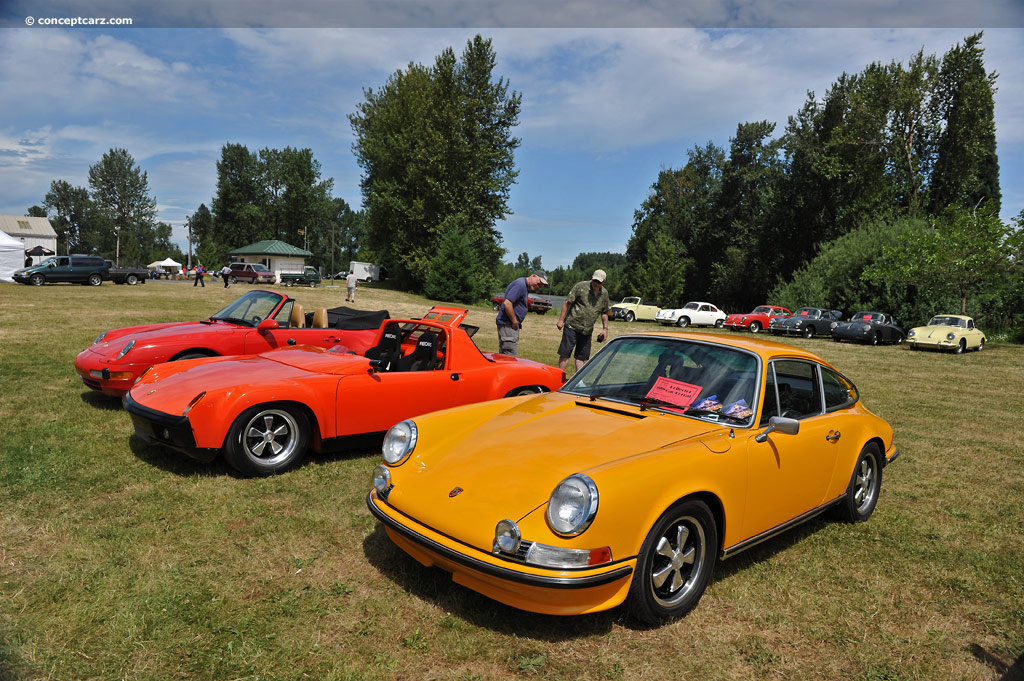
Coupe
by Daniel Vaughan | Mar 2021
Related Reading : Porsche 911 History
The legendary Porsche 911 is the longest production run sports car of all time. It was conceived as a successor for the highly successful Porsche 356 and from the start had high aspirations for success. Ferry Porsches son, Ferdinand Alexander Porsche, designed the 911. When it went into production it was labeled the 901 but Peugeot had claims to the name, so to avoid infringing on their naming scheme,....
Continue Reading >>
Continue Reading >>
Related Reading : Porsche 911 History
Who could predict that the 911 would be Porsches saving grace and surpass the 356 in sales, longevity Quickly establishing itself as an icon of 60s cool, the iconic 911 only became more popular as the years went on. The flagship of the current lineup of Porsche, the 911 (pronounced Nine Eleven) or Neunelfer is a two-door grand tourer with a very distinctive design. The 911 is one of the oldest....
Continue Reading >>
Continue Reading >>
Similar Automakers
Similarly Sized Vehicles
from 1972
1972 Porsche 911T Vehicle Profiles
Recent Vehicle Additions
Performance and Specification Comparison
Price Comparison
$6,000
$7,255 - $10,200
$8,000 - $8,700
$9,450 - $10,235
E and F series - 2.4-litre Specification Comparison by Year
Year
Production
Wheelbase
Engine
Prices
89.40 in.
6 cyl., 142.86 CID., 157.00hp
6 cyl., 142.86 CID., 185.00hp
6 cyl., 142.86 CID., 210.00hp
6 cyl., 142.86 CID., 185.00hp
6 cyl., 142.86 CID., 210.00hp
$7,255 - $10,200
Related Automotive News

FROM INCLEMENT WEATHER TO HARSH, OFF-ROAD ENVIRONMENTS, FCA US DRIVELINES DELIVER FULL RANGE OF CAPABILITY
Multiple segment-first and segment-exclusive applications of fuel-saving axle-disconnect and active-transfer-case technologies
Rugged 4x4 systems deliver legendary off-road performance
All-wheel-drive and 4x4 systems engineered and calibrated to c...

ENGINE STOP-START TECHNOLOGY NOW STANDARD WITH V-6 IN AWARD-WINNING JEEP CHEROKEE AND I-4 IN ALL-NEW 2015 CHRYSLER 200
Estimated fuel-economy improvement up to 3
Estimated C02 emissions-reduction up to 3
Enhanced high-speedhigh-durability starter and advanced control strategies contribute to seamless, automatic activation
Intuitively adapts to driving styles f...

Jeep Brand Debuts Four Design Concept Vehicles at the Beijing Motor Show
Four Chinese-inspired design concepts push boundaries of Jeep brand
Jeep Zi You Xia design concept showcases a sophisticated interpretation of the all-new Jeep Renegade
Jeep Wrangler Sundancer brings premium luxury to the iconic model
Jeep Cherok...

POPULAR JEEP® ALTITUDE MODELS RETURN FOR 2014
2014 Jeep Cherokee, Grand Cherokee and Wrangler debut special-edition Altitude models
New Jeep Altitude models feature unique blacked out exteriors with distinct, aggressive flair
Available for first time on Cherokee, and returning for Grand Che...
World-First Driveline, Breakthrough Transmission, Four New Engines Mark Milestone Model-Year For Chrysler Group
Worlds first front-wheel-drive-based 4x4 system with rear-axle disconnect
Worlds first nine-speed automatic transmission – one of three new gearboxes
New 6.4-liter HEMI® V-8, mightiest gasoline engine in heavy-duty pickup segment
New 3.0-liter...
